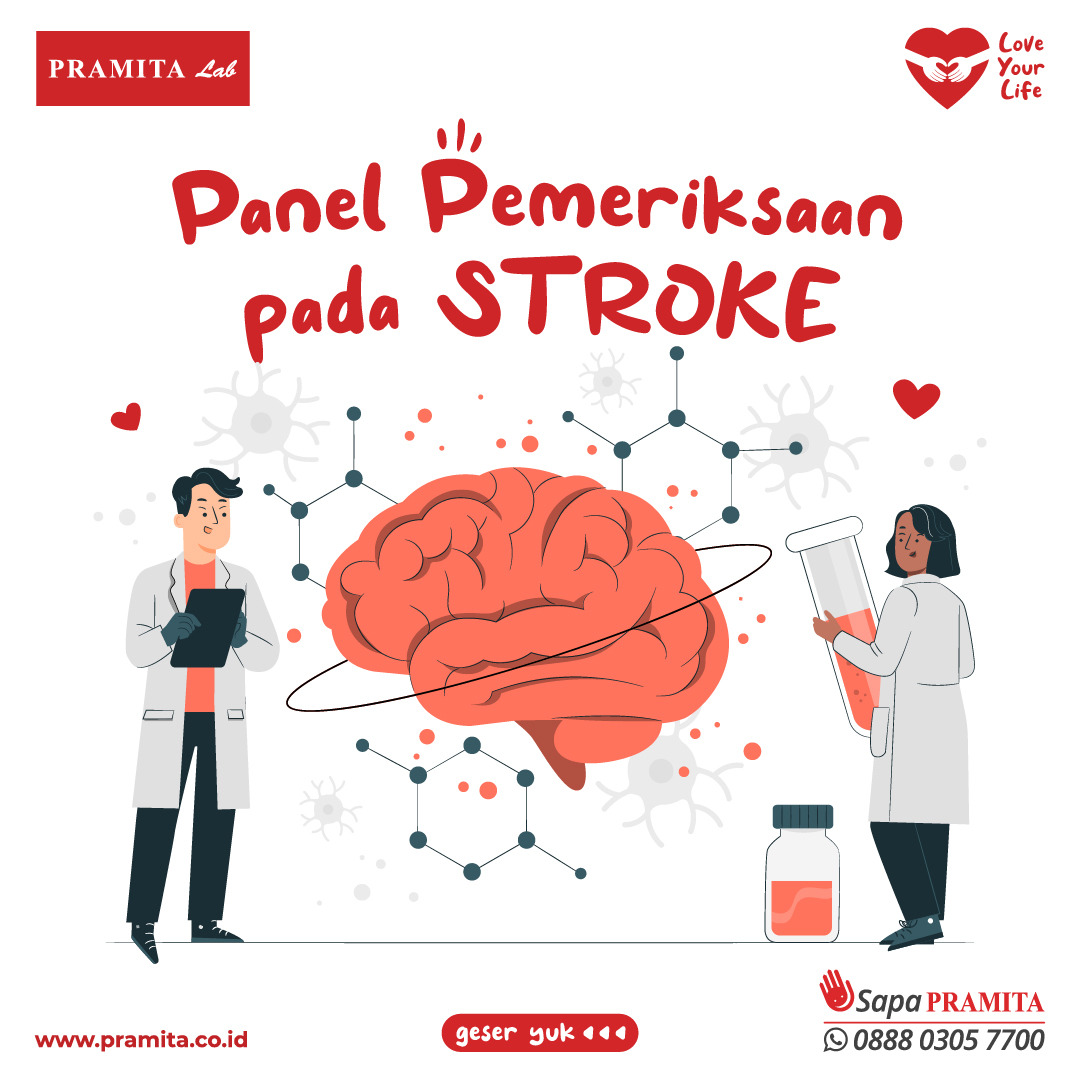Healthy Inspirations
Semua
Work Life
INFO PEMERIKSAAN
Parenting/Kesehatan Anak
LabPedia
Life Style
Kesehatan Wanita
Health Info
Millenial
Info Kesehatan
Mitos/Fakta

CHECK PANEL ON STROKE
Thu, 10 Nov 2022
The diagnosis of stroke can begin with a history followed by a physical examination and laboratory and non-laboratory supporting examinations.
Perform history taking to determine risk factors, events before stroke - history of trauma - onset. Then proceed with a physical examination in the form of a GCS (consciousness) examination, examination of blood pressure, heart rate, pulse and neurological examination.
To diagnose, laboratory and non-laboratory supporting examinations are needed such as: CT-Scan examination (this test uses X-rays to produce a more detailed picture of the brain, determine the location of bleeding, how much damage to brain tissue is).
STROKE INSPECTION PANEL
To determine the risk of stroke, supporting examinations are carried out, as follows:
a. Laboratory Examination Panel
1. Complete Hematology
2. Blood Clotting Factors (PT-INR, APTT)
3. Platelet Aggregation Test
4. Fat Profile
5. Blood Glucose
6. Blood Electrolytes
b. Non Laboratory Examination Panel
1. ECG
2. Thorax photos can see the condition of the heart, whether there is an enlarged heart which is one of the signs of chronic hypertension in stroke patients.
3. Transcranial Doppler (TCD) examination
One of the diagnostic tests to detect blood vessel flow, especially in the head and brain area.
The way Trans Cranial Doppler works is similar to an ultrasound (ultrasonography) tool, it does not use radiation so that it can be done repeatedly for monitoring without causing harmful side effects to the body.
This Trans Cranial method has the advantage that the procedure uses non-invasive techniques so that the patient will not feel discomfort during the examination. The patient can lie down or sit in a chair. The patient will also remain conscious during this procedure. This examination does not require the use of contrast agents that have side effects such as allergies.
Indications for transcranial Doppler examination are generally to see the condition of stroke. This is due to the accuracy of the information provided by trans cranial doppler to understand the stroke that has occurred in a person so that prevention, treatment and explanation of the prognosis can be done.
Uses of the Trans Cranial Doppler (TCD) examination:
• Can be used to detect the presence of impaired blood flow due to stenosis or blockage of blood vessels
• Can detect embolism, blood vessel spasm
• Can find out the possibility of stroke and evaluate the results of post-stroke therapy
• Can help assess the risk of stroke in patients with high risk factors such as hypertension, dyslipidemia (high cholesterol), obesity, heart disease, diabetes.
• Can be used to support other diagnostic tools such as CT Scan, MRI
• Can detect brain death.
Who should perform a Trans Cranial Doppler (TCD) examination?
• Patients with Dyslipidemia (high cholesterol levels) due to high cholesterol or triglycerides can increase the risk of narrowing that occurs due to plaque deposits on the artery walls
• Cardiovascular Disease
• Diabetics
• Hypertension Patients
• Sickle Cell Anemia due to this type of anemia reduces the number of red blood cells that carry oxygen so that it can clog blood vessels
• Trauma to the brain for example due to an accident or violence resulting in bleeding in the brain.
REFERENCE
Malani PN. Harrison's principles of internal medicine. JAMA. 2012 Nov 7; 308 (17)
Vilela P. Acute Stroke Differential Diagnosis : Stroke mimics. European Journal of radiology. 2017 Nov 1; 96:133
Sutanto. CEKAL (Prevent & Prevent) Modern Diseases. Yogyakarta: Andi Publishers; 2010
Misbach J. Stroke Guideline for 2011. PERDOSSI: Jakarta; 2011
American Heart Association Statistics Committee and Stroke Statistics Subcommitte. Heart disease and stroke statistics-2016 update; a report form the American Heart Association. Circulation. 2016.
Matta B, Czosnyka M. Transcranial doppler ultrasonography in anesthesia and neurosurgery. In Cottrell JE, Patel P, 2017 p131
Author: dr. Nirma Amalia (Medical Consultant Doctor of PRAMITA Clinical Laboratory Jl. Karunrung No. 9, Makassar)
Perform history taking to determine risk factors, events before stroke - history of trauma - onset. Then proceed with a physical examination in the form of a GCS (consciousness) examination, examination of blood pressure, heart rate, pulse and neurological examination.
To diagnose, laboratory and non-laboratory supporting examinations are needed such as: CT-Scan examination (this test uses X-rays to produce a more detailed picture of the brain, determine the location of bleeding, how much damage to brain tissue is).
STROKE INSPECTION PANEL
To determine the risk of stroke, supporting examinations are carried out, as follows:
a. Laboratory Examination Panel
1. Complete Hematology
2. Blood Clotting Factors (PT-INR, APTT)
3. Platelet Aggregation Test
4. Fat Profile
5. Blood Glucose
6. Blood Electrolytes
b. Non Laboratory Examination Panel
1. ECG
2. Thorax photos can see the condition of the heart, whether there is an enlarged heart which is one of the signs of chronic hypertension in stroke patients.
3. Transcranial Doppler (TCD) examination
One of the diagnostic tests to detect blood vessel flow, especially in the head and brain area.
The way Trans Cranial Doppler works is similar to an ultrasound (ultrasonography) tool, it does not use radiation so that it can be done repeatedly for monitoring without causing harmful side effects to the body.
This Trans Cranial method has the advantage that the procedure uses non-invasive techniques so that the patient will not feel discomfort during the examination. The patient can lie down or sit in a chair. The patient will also remain conscious during this procedure. This examination does not require the use of contrast agents that have side effects such as allergies.
Indications for transcranial Doppler examination are generally to see the condition of stroke. This is due to the accuracy of the information provided by trans cranial doppler to understand the stroke that has occurred in a person so that prevention, treatment and explanation of the prognosis can be done.
Uses of the Trans Cranial Doppler (TCD) examination:
• Can be used to detect the presence of impaired blood flow due to stenosis or blockage of blood vessels
• Can detect embolism, blood vessel spasm
• Can find out the possibility of stroke and evaluate the results of post-stroke therapy
• Can help assess the risk of stroke in patients with high risk factors such as hypertension, dyslipidemia (high cholesterol), obesity, heart disease, diabetes.
• Can be used to support other diagnostic tools such as CT Scan, MRI
• Can detect brain death.
Who should perform a Trans Cranial Doppler (TCD) examination?
• Patients with Dyslipidemia (high cholesterol levels) due to high cholesterol or triglycerides can increase the risk of narrowing that occurs due to plaque deposits on the artery walls
• Cardiovascular Disease
• Diabetics
• Hypertension Patients
• Sickle Cell Anemia due to this type of anemia reduces the number of red blood cells that carry oxygen so that it can clog blood vessels
• Trauma to the brain for example due to an accident or violence resulting in bleeding in the brain.
REFERENCE
Malani PN. Harrison's principles of internal medicine. JAMA. 2012 Nov 7; 308 (17)
Vilela P. Acute Stroke Differential Diagnosis : Stroke mimics. European Journal of radiology. 2017 Nov 1; 96:133
Sutanto. CEKAL (Prevent & Prevent) Modern Diseases. Yogyakarta: Andi Publishers; 2010
Misbach J. Stroke Guideline for 2011. PERDOSSI: Jakarta; 2011
American Heart Association Statistics Committee and Stroke Statistics Subcommitte. Heart disease and stroke statistics-2016 update; a report form the American Heart Association. Circulation. 2016.
Matta B, Czosnyka M. Transcranial doppler ultrasonography in anesthesia and neurosurgery. In Cottrell JE, Patel P, 2017 p131
Author: dr. Nirma Amalia (Medical Consultant Doctor of PRAMITA Clinical Laboratory Jl. Karunrung No. 9, Makassar)

